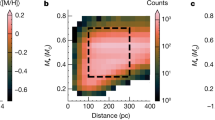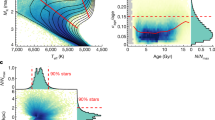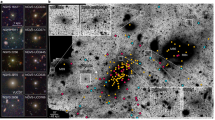Abstract
Galaxy formation entails the hierarchical assembly of mass, along with the condensation of baryons and the ensuing, self-regulating star formation1,2. The stars form a collisionless system whose orbit distribution retains dynamical memory that can constrain a galaxy’s formation history3. The orbits dominated by ordered rotation, with near-maximum circularity λ z ≈ 1, are called kinematically cold, and the orbits dominated by random motion, with low circularity λ z ≈ 0, are kinematically hot. The fraction of stars on ‘cold’ orbits, compared with the fraction on ‘hot’ orbits, speaks directly to the quiescence or violence of the galaxies’ formation histories4,5. Here we present such orbit distributions, derived from stellar kinematic maps through orbit-based modelling for a well-defined, large sample of 300 nearby galaxies. The sample, drawn from the CALIFA survey6, includes the main morphological galaxy types and spans a total stellar mass range from 108.7 to 1011.9 solar masses. Our analysis derives the orbit-circularity distribution as a function of galaxy mass and its volume-averaged total distribution. We find that across most of the considered mass range and across morphological types, there are more stars on ‘warm’ orbits defined as 0.25 ≤ λ z ≤ 0.8 than on either ‘cold’ or ‘hot’ orbits. This orbit-based ‘Hubble diagram’ provides a benchmark for galaxy formation simulations in a cosmological context.
This is a preview of subscription content, access via your institution
Access options
Access Nature and 54 other Nature Portfolio journals
Get Nature+, our best-value online-access subscription
$29.99 / 30 days
cancel any time
Subscribe to this journal
Receive 12 digital issues and online access to articles
$119.00 per year
only $9.92 per issue
Buy this article
- Purchase on Springer Link
- Instant access to full article PDF
Prices may be subject to local taxes which are calculated during checkout




Similar content being viewed by others
References
Mo, H., van den Bosch, F. C. & White, S. Galaxy Formation and Evolution (Cambridge Univ. Press, Cambridge, 2010).
White, S. D. M. & Rees, M. J. Core condensation in heavy halos—a two-stage theory for galaxy formation and clustering. Mon. Not. R. Astron. Soc. 183, 341–358 (1978).
Lagos, C. d. P. et al. Quantifying the impact of mergers on the angular momentum of simulated galaxies. Preprint available at https://arxiv.org/abs/1701.04407 (2017).
Röttgers, B., Naab, T. & Oser, L. Stellar orbits in cosmological galaxy simulations: the connection to formation history and line-of-sight kinematics. Mon. Not. R. Astron. Soc. 445, 1065–1083 (2014).
Bird, J. C. et al. Inside out and upside down: tracing the assembly of a simulated disk galaxy using mono-age stellar populations. Astrophys. J. 773, 43 (2013).
Sánchez, S. F. et al. CALIFA, the calar alto legacy integral field area survey. I. Survey presentation. Astron. Astrophys. 538, A8 (2012).
Aihara, H. et al. The eighth data release of the sloan digital sky survey: first data from SDSS-III. Astrophys. J. Suppl. Ser. 193, 29 (2011).
Walcher, C. J. et al. CALIFA: a diameter-selected sample for an integral field spectroscopy galaxy survey. Astron. Astrophys. 569, A1 (2014).
Schwarzschild, M. Self-consistent models for galactic halos. Astrophys. J. 409, 563–577 (1993).
Binney, J. Rotation and anisotropy of galaxies revisited. Mon. Not. R. Astron. Soc. 363, 937–942 (2005).
Cappellari, M. et al. The SAURON project—X. The orbital anisotropy of elliptical and lenticular galaxies: revisiting the (V/σ, ε) diagram with integral-field stellar kinematics. Mon. Not. R. Astron. Soc. 379, 418–444 (2007).
Emsellem, E. et al. The ATLAS3D project—III. A census of the stellar angular momentum within the effective radius of early-type galaxies: unveiling the distribution of fast and slow rotators. Mon. Not. R. Astron. Soc. 414, 888–912 (2011).
Brough, S. et al. The SAMI Galaxy Survey: mass as the driver of the kinematic morphology–density relation in clusters. https://arxiv.org/abs/1704.01169 (2017).
Obreja, A. et al. NIHAO VI. The hidden discs of simulated galaxies. Mon. Not. R. Astron. Soc. 459, 467–486 (2016).
Freeman, K. C. On the disks of spiral and S0 galaxies. Astrophys. J. 160, 811 (1970).
Weinzirl, T., Jogee, S., Khochfar, S., Burkert, A. & Kormendy, J. Bulge n and B/T in high-mass galaxies: constraints on the origin of bulges in hierarchical models. Astrophys. J. 696, 411–447 (2009).
Comerón, S. et al. Breaks in thin and thick disks of edge-on galaxies imaged in the Spitzer Survey of Stellar Structure in Galaxies (S4G). Astrophys. J. 759, 98 (2012).
Lagos, C.d. P. et al. Angular momentum evolution of galaxies in EAGLE. Mon. Not. R. Astron. Soc. 464, 3850–3870 (2017).
Stinson, G. S. et al. Making galaxies in a cosmological context: the need for early stellar feedback. Mon. Not. R. Astron. Soc. 428, 129–140 (2013).
Vogelsberger, M. et al. Introducing the illustris project: simulating the coevolution of dark and visible matter in the Universe. Mon. Not. R. Astron. Soc. 444, 1518–1547 (2014).
Schaye, J. et al. The EAGLE project: simulating the evolution and assembly of galaxies and their environments. Mon. Not. R. Astron. Soc. 446, 521–554 (2015).
Wang, L. et al. NIHAO project—I. Reproducing the inefficiency of galaxy formation across cosmic time with a large sample of cosmological hydrodynamical simulations. Mon. Not. R. Astron. Soc. 454, 83–94 (2015).
Hopkins, P. F. et al. Galaxies on FIRE (Feedback In RealisticEnvironments): stellar feedback explains cosmologically inefficient star formation. Mon. Not. R. Astron. Soc. 445, 581–603 (2014).
Falcón-Barroso, J. et al. Stellar kinematics across the Hubble sequence in the CALIFA survey: general properties and aperture corrections. Astron. Astrophys. 597, A48 (2017).
Sánchez, S. F. et al. CALIFA, the Calar Alto legacy integral field area survey. IV. Third public data release. Astron. Astrophys. 594, A36 (2016).
Cappellari, M. & Copin, Y. Adaptive spatial binning of integral-field spectroscopic data using Voronoi tessellations. Mon. Not. R. Astron. Soc. 342, 345–354 (2003).
Kroupa, P. On the variation of the initial mass function. Mon. Not. R. Astron. Soc. 322, 231–246 (2001).
Schwarzschild, M. A numerical model for a triaxial stellar system in dynamical equilibrium. Astrophys. J. 232, 236–247 (1979).
van den Bosch, R. C. E., van de Ven, G., Verolme, E. K., Cappellari, M. & de Zeeuw, P. T. Triaxial orbit based galaxy models with an application to the (apparent) decoupled core galaxy NGC 4365. Mon. Not. R. Astron. Soc. 385, 647–666 (2008).
Zhu, L., van den Bosch, R. & van de Ven, G. Orbital decomposition of CALIFA spiral galaxies. Mon. Not. R. Astron. Soc. 473, 3000–3018 (2018).
Cappellari, M. Efficient multi-Gaussian expansion of galaxies. Mon. Not. R. Astron. Soc. 333, 400–410 (2002).
Dutton, A. A. & Macciò, A. V. Cold dark matter haloes in the Planck era: evolution of structural parameters for Einasto and NFW profiles. Mon. Not. R. Astron. Soc. 441, 3359–3374 (2014).
Falcón-Barroso, J. et al. Stellar kinematics across the Hubble sequence in the CALIFA survey: General properties and aperture corrections. Astron. Astrophys. 597, A48 (2017).
Shen, J. et al. Our Milky Way as a pure-disk galaxy: a challenge for galaxy formation. Astrophys. J. Lett. 720, L72–L76 (2010).
Grand, R. J. J. et al. The Auriga Project: the properties and formation mechanisms of disc galaxies across cosmic time. Mon. Not. R. Astron. Soc. 467, 179–207 (2017).
Nelson, D. et al. The Illustris simulation: public data release. Astron. Comput. 13, 12–37 (2015).
Stinson, G. S. et al. NIHAO III: the constant disc gas mass conspiracy. Mon. Not. R. Astron. Soc. 454, 1105–1116 (2015).
Marinacci, F. et al. Properties of H i discs in the Auriga cosmological simulations. Mon. Not. R. Astron. Soc. 466, 3859–3875 (2017).
Barnes, J. & Hut, P. A hierarchical O(N log N) force-calculation algorithm. Nature 324, 446–449 (1986).
Acknowledgements
This study uses the data provided by the Calar Alto Legacy Integral Field Area (CALIFA) survey (http://califa.caha.es) based on observations collected at the Centro Astronómico Hispano Alemán at Calar Alto, operated jointly by the Max-Planck Institut für Astronomie and the Instituto de Astrofísica de Andalucía. We thank A. van der Wel, K. Jahnke, V. Debattista and M. Fouesneau for discussions. G.v.d.V. and J.F.-B. acknowledge support from the DAGAL network from the People Programme (Marie Curie Actions) of the European Unions Seventh Framework Programme FP7/2007–2013 under REA grant agreement number PITN-GA-2011-289313. G.v.d.V. also acknowledges support from the Sonderforschungsbereich SFB 881 “The Milky Way System” (subprojects A7 and A8) funded by the German Research Foundation, and funding from the European Research Council under the European Union’s Horizon 2020 research and innovation programme under grant agreement no. 724857 (Consolidator grant ‘ArcheoDyn’). This work was supported by the National Science Foundation of China (grant no. 11333003, 11390372 to SM). A.O. has been funded by the Deutsche Forschungsgemeinschaft (German Research Foundation) – MO 2979/1–1. J.F.-B. acknowledges support from grant AYA2016-77237-C3-1-P from the Spanish Ministry of Economy and Competitiveness. R.J.J.G. acknowledges support by the DFG Research Centre SFB-881 ‘The Milky Way System’ through project A1.
Author information
Authors and Affiliations
Contributions
Text, figures and interpretation are by L.Z., G.v.d.V., H.-W.R., M.M. and S.M. Modelling is by L.Z., R.v.d.B. and G.v.d.V. Observational data are from J.F.B., M.L., G.v.d.V., J.C.W., R.G.B., S.Z. and S.F.S. Methodology is by L.Z., D.X., Y.J., A.O., R.J.J.G., A.V.M., A.A.D. and F.A.G.
Corresponding author
Ethics declarations
Competing interests
The authors declare no competing financial interests.
Additional information
Publisher’s note: Springer Nature remains neutral with regard to jurisdictional claims in published maps and institutional affiliations.
Supplementary information
Supplementary Information
Supplementary Tables 1–3, Supplementary Figures 1–4
Rights and permissions
About this article
Cite this article
Zhu, L., Ven, G., Bosch, R. et al. The stellar orbit distribution in present-day galaxies inferred from the CALIFA survey. Nat Astron 2, 233–238 (2018). https://doi.org/10.1038/s41550-017-0348-1
Received:
Accepted:
Published:
Issue Date:
DOI: https://doi.org/10.1038/s41550-017-0348-1
This article is cited by
-
Baryonic properties of nearby galaxies across the stellar-to-total dynamical mass relation
Nature Astronomy (2024)



